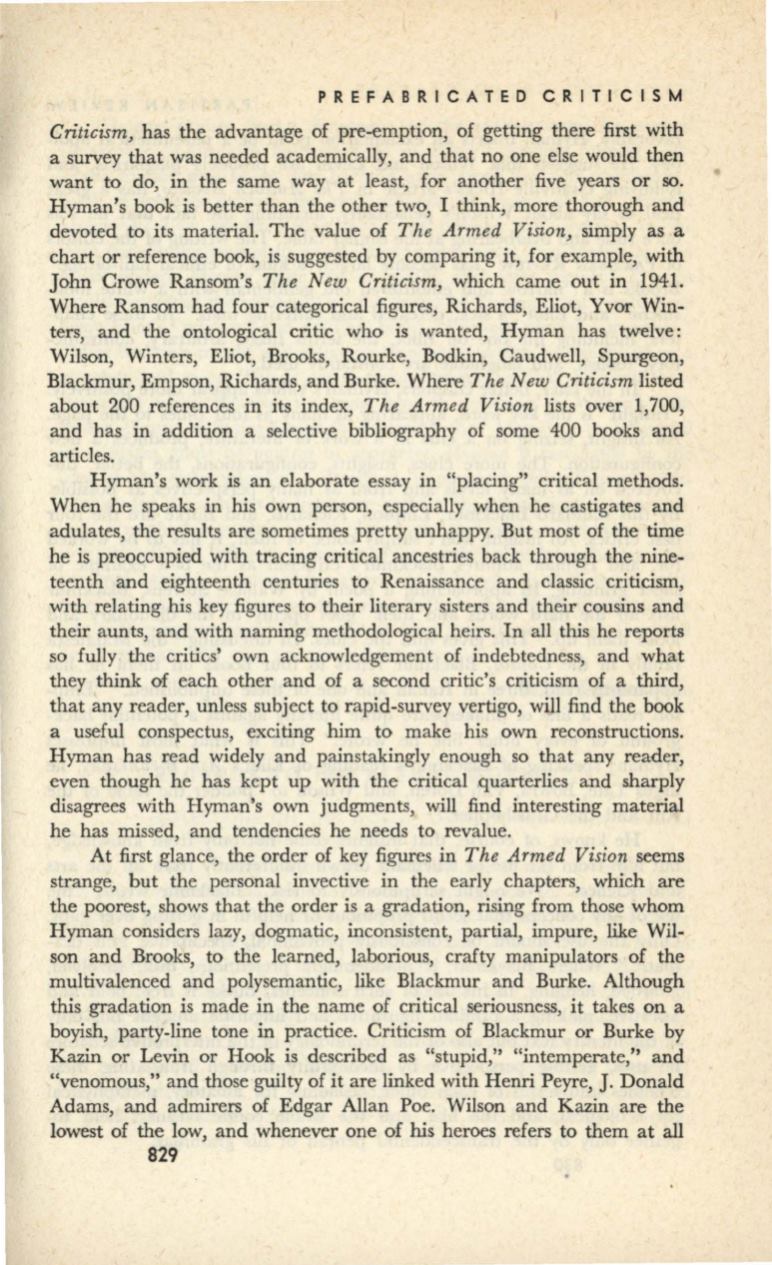
PREFABRICATED CRITICISM
Criticism,
has the advantage of pre-emption, of getting there first with
a survey that was needed academically, and that no one else would then
want to do, in the same way at least, for another five years or so.
Hyman's book is better than the other two, I think, more thorough and
devoted to its material. The value of
The Armed Vision,
simply as a
chart or reference book, is suggested by comparing it, for example, with
John Crowe Ransom's
The New Criticism,
which came out in 1941.
Where Ransom had four categorical figures, Richards, Eliot, Yvor Win–
ters, and the ontological critic who is wanted, Hyman has twelve:
Wilson, Winters, Eliot, Brooks, Rourke, Bodkin, Caudwel!, Spurgeon,
Blackmur, Empson, Richards, and Burke. Where
The New Criticism
listed
about 200 references in its index,
The Armed Vision
lists over 1,700,
and has in addition a selective bibliography of some 400 books and
articles.
Hyman's work is an elaborate essay in "placing" critical methods.
When he speaks in his own person, especially when he castigates and
adulates, the results are sometimes pretty unhappy. But most of the time
he is preoccupied with tracing critical ancestries back through the nine–
teenth and eighteenth centuries to Renaissance and classic criticism,
with relating his key figures to their literary sisters and their cousins and
their aunts, and with naming methodological heirs. In all this he reports
so fully the critics' own acknowledgement of indebtedness, and what
they think of each other and of a second critic's criticism of a third,
that any reader, unless subject to rapid-survey vertigo, will find the book
a useful conspectus, exciting him to make his own reconstructions.
Hyman has read widely and painstakingly enough so that any reader,
even though he has kept up with the critical .quarterlies and sharply
disagrees with Hyman's own judgments, will find interesting material
he has missed, and tendencies he needs to revalue.
At first glance, the order of key figures in
The Armed Vision
seems
strange, but the personal invective in the early chapters, which are
the poorest, shows that the order is a gradation, rising from those whom
Hyman considers lazy, dogmatic, inconsistent, partial, impure, like Wil–
son and Brooks, to the learned, laborious, crafty manipulators of the
multivalenced and polysemantic, like Blackmur and Burke. Although
this gradation is made in the name of critical seriousness, it takes on a
boyish, party-line tone in practice. Criticism of Blackmur or Burke by
Kazin or Levin or Hook is described as "stupid,'' "intemperate," and
"venomous," and those guilty of it are linked with Henri Peyre,
J.
Donald
Adams, and admirers of Edgar Allan Poe. Wilson and Kazin are the
lowest of the low, and whenever one of his heroes refers to them at all
829


